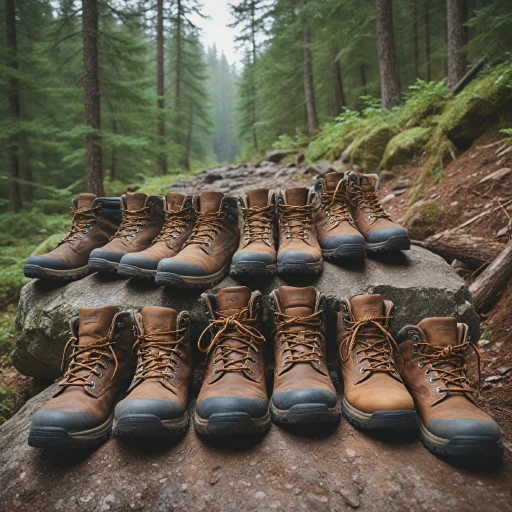
Understanding the Importance of Boot Thickness
The Role of Thickness in Hiking Boots
When it comes to hiking boots, thickness plays a crucial role in providing the necessary support and protection for your feet. The thickness of a boot can significantly impact your hiking experience, especially on challenging terrains. A thicker boot often means more cushioning, which helps keep your feet dry and comfortable during long hikes.
Thick hiking boots are designed to withstand the rigors of tough trails, offering enhanced durability and stability. This is particularly important for those who engage in heavy-duty hiking or mountaineering. The added thickness can also contribute to better insulation, keeping your feet warm in colder climates.
However, it's essential to understand that not all thick boots are created equal. The materials and construction of these boots can vary, affecting their overall performance and comfort. For instance, leather boots are known for their durability and classic look, while modern synthetic materials might offer lighter weight and improved breathability.
Choosing the right thickness for your hiking boots depends on several factors, including the type of terrain you'll be tackling and the weather conditions you expect to encounter. It's also important to consider the fit and size of the boot, as a proper fit ensures that the thickness provides the intended support without causing discomfort.
For those interested in exploring different hiking conditions, such as wet environments, it's worth checking out choosing the right hiking footwear for wet conditions to ensure you're prepared for any adventure.
Materials and Construction of Thick Hiking Boots
Delving Into Boot Construction
When it comes to the anatomy of thick hiking boots, the materials and construction methods play a pivotal role in determining their durability and performance on rugged terrains. Let's break down what makes these boots an essential item for your hiking repertoire.
Material Matters
The backbone of any high-quality hiking boot is its material. Leather remains a popular choice among avid hikers, especially due to its robust nature and adaptability. Full-grain leather, often seen in the best sellers like Nicks Boots, offers excellent abrasion resistance and breathability, which helps keep feet dry during long hikes. For those looking for a more iconic appearance, black leather options are quite prevalent and favored for their sleek look.
Beyond traditional leather, some manufacturers incorporate bison leather, which is known for its unparalleled thickness and durability, making it a top choice for heavy-duty hikes. The construction often includes safety and moc toe designs to cater to different functional needs, from purpose work boots to regular hiking.
Construction Techniques
How these materials are assembled significantly impacts their performance and lifespan. Many thick boots incorporate Goodyear welt or cement construction methods to ensure endurance against the elements. These methods not only enhance durability but also improve the boot’s fit over time. This breaking-in phase is crucial to ensuring that the boots work harmoniously with your feet.
Features for Optimal Performance
Thick boots often feature slip-resistant soles for better traction on slippery surfaces, essential for both work boots and hiking variants. Customer reviews often emphasize the value of this feature for maintaining stability. Furthermore, items with additional filling like white fleece linings add insulation, making them suitable for colder climates.
When considering the price and size for these products, keep in mind that a higher investment in materials often equals a longer-lasting boot. Sale prices and limited offerings can provide opportunities to snag a high-quality boot for a regular price. Be sure to check this detailed comparison of versatile hiking boots for an in-depth understanding of different options on the market.
Comparing Thick Boots: Features and Benefits
Key Features and Benefits of Thick Hiking Boots
When it comes to hiking boots, thickness is more than just a matter of comfort; it’s about ensuring your feet stay protected and supported on challenging terrains. Thick hiking boots are designed to offer a range of features that cater to both experienced hikers and mountaineers. Here’s a closer look at what makes these boots a best seller among outdoor enthusiasts.
- Material and Construction: Thick hiking boots often feature durable materials like leather and heavy-duty synthetics. These materials not only provide excellent protection but also ensure the boots are slip resistant, keeping your feet dry in wet conditions. The construction often includes a safety toe or moc toe for added protection.
- Support and Stability: The added thickness in these boots provides superior ankle support, which is crucial for preventing injuries on uneven trails. The robust build also helps in maintaining a stable footing, reducing the risk of slips and falls.
- Comfort and Fit: Despite their bulk, many thick hiking boots are designed to offer a comfortable fit. They often come with a break period to allow the boots to mold to your feet, ensuring a snug fit without compromising on comfort.
- Durability and Longevity: These boots are built to withstand the toughest conditions. With proper care, they can last for years, making them a worthwhile investment despite their higher price tag compared to regular boots.
- Versatility: While primarily designed for hiking, these boots can double as work boots, offering the same level of protection and support in a variety of environments.
Customer reviews often highlight the durability and comfort of these boots, making them a popular choice for those who spend extended periods on their feet. Whether you’re tackling a rugged mountain trail or working in demanding conditions, thick hiking boots are a reliable choice that won’t disappoint.
Challenges of Wearing Thick Hiking Boots
Faces of Thick Hiking Boots: Weighing the Pros and Cons
Thick hiking boots can be a blessing, but they come with their own set of challenges. These boots, designed with added layers, are perfect for specific environments but might not suit every hiker's needs or preferences. Firstly, it's important to acknowledge that while these boots offer significant support, they can also be cumbersome. The increased weight, due to the additional materials used in their construction, can result in fatigue over long distances. Imagine carrying around a work boot for hours; unless conditioned, it’s a sure path to sore feet. When it comes to fit, thick boots might not offer the same versatility as regular options. Finding the right size can be tricky, especially when dealing with added layers that expand beyond the usual boot profile. A mismatch in size, like when a safety toe feature is used improperly, can easily lead to discomfort. Additionally, newcomers to thick boots may experience a "break period." This is a crucial phase where the boots work themselves to mold better to your feet over repeated use. During this time, some might face the challenge of keeping their feet dry, especially if the boots are not properly broken in. Let's not forget the price. Thick hiking boots, often seen as a heavy duty product, come with a price tag to match their engineering. Regular price and sale price variations can influence the decision; yet, investing in a product that promises longevity and protection could be well worth the initial outlay. In terms of reviews and customer experiences, opinions vary. Some users praise the slip-resistant soles and heavy-duty materials that protect in rugged terrains. Others point out the limitations in comfort and maneuverability when compared to lighter footwear options. Ultimately, finding the toughest hiking boots that align perfectly with your adventures requires careful consideration of these factors. Selecting the right hiking boots is all about balancing the layers of support with your personal hiking style and the terrains you plan to conquer. Remember, every adventure is unique, and choose accordingly, keeping in mind that everything from black and bison leather choices to the moc toe styles can impact your expedition.Choosing the Right Thick Boot for Your Adventure
Selecting the Ultimate Hiking Boot for Your Needs
When it comes to choosing the perfect thick hiking boots, understanding your requirements is key. A well-chosen boot not only ensures your comfort and safety on the trail but also aligns with your budget and style preferences. Below are factors to consider when making your selection:- Purpose and Terrain: Determine if you'll be needing a regular work boot or a specialized item designed for rugged terrains. Different boots fit different purposes; for example, if you're going to be navigating rocky paths, you might want to look for safety toe features or heavy-duty options.
- Fit and Comfort: Ensuring the best fit is crucial. Consider the size chart meticulously, especially since a break period might be needed. Boots work effectively in preventing blisters and keeping feet dry when they are properly fitted.
- Material: From nicks boots to premium leather, choosing the right material affects comfort, durability, and weight. While leather options may command a higher price regular, they often offer excellent longevity and support.
- Design and Style: Whether it's the classic moc toe or sleek black, design matters. Some styles, such as the bison leather, may be considered best seller items due to their unique look and durability.
- Price vs. Value: From limited edition to sale price offerings, evaluate customer reviews and review product ratings to understand what provides the best value at a price regular. Be wary of products at a sale price that don’t live up to their claims in reviews.
- Safety Features: In addition to evaluating slip-resistant soles, consider boots with add-ons like a safety toe if the work environment demands extra protection.














